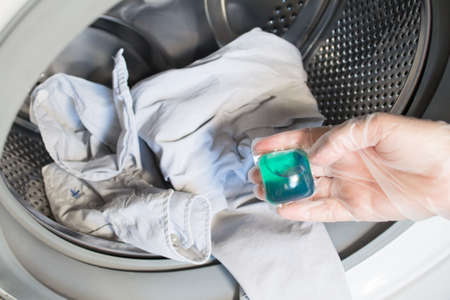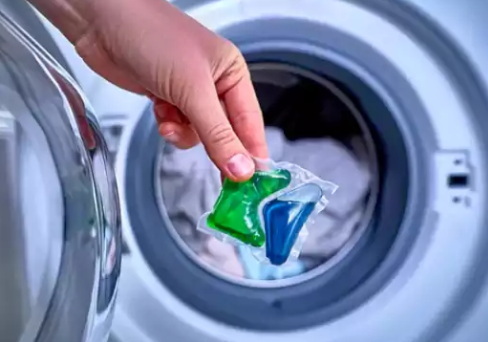Dongguan UFine Daily Chemical Co.,Ltd.
- All
- Product Name
- Product Keyword
- Product Model
- Product Summary
- Product Description
- Multi Field Search
Views: 222 Author: Tomorrw Publish Time: 10-29-2025 Origin: Site











Content Menu
● Dissolution Mechanisms in Detail
● Factors Affecting Dissolution
● Design Strategies for Faster and More Complete Dissolution
● Sustainability and Safety-Driven Design
● Practical Usage Tips for Consumers
● Common Issues and Troubleshooting
● Environmental and Safety Considerations
● Regulatory and Compliance Considerations
● Market Trends and Consumer Expectations
● FAQ
>> 1. How quickly should a laundry pod dissolve in a typical washing machine?
>> 2. Can I use laundry pods in cold water?
>> 3. What causes pods to leave a residue on clothes?
>> 4. Are pod shells harmful if touched?
>> 5. How can I improve dissolution if my washer isn't effectively dissolving pods?
Laundry pods have transformed household laundry by offering convenient, pre-measured dosing. However, users sometimes encounter pods that fail to dissolve fully, leaving residues on clothing or in washing machines. This article explains the science behind pod dissolution, factors that influence it, and practical steps to ensure optimal performance. The goal is to help manufacturers, formulators, and informed consumers understand why pods dissolve and how to design and use them effectively.

Laundry pods are typically multilayered capsules containing a concentrated detergent core and a protective shell. The core often comprises a blend of surfactants, enzymes, bleaching agents, builders, and specialty additives. The shell is usually a hydrogel or other water-soluble polymer that dissolves when exposed to water. Key considerations include:
- Shell materials: The choice of polymer affects dissolution rate, integrity in storage, and release profile.
- Core formulation: Concentration and compatibility of surfactants, enzymes, and stabilizers influence cleaning performance and dissolution behavior.
- Gel strength vs. solubility: A balance between shell robustness during handling and rapid dissolution in wash water is essential.
- Additive distribution: Uniform dispersion of actives within the core ensures consistent release upon dissolution.
Dissolution of a laundry pod is a sequence of events occurring when the pod encounters water:
- Initial hydration: Water permeates the outer shell and softens it, initiating shell dissolution.
- Shell rupture: Mechanical agitation and swelling create micro-cracks, accelerating core exposure.
- Core dispersion: The concentrated detergent core is released and dispersed in the wash water, aided by surfactants that reduce surface tension and improve wetting.
- Secondary dissolution: Any remaining shell fragments dissolve, contributing to the total cleaning effort.
- Interaction dynamics: Surfactants, enzymes, and bleaching agents may interact with water hardness and other ions, influencing overall performance.
Several variables determine how quickly and completely a laundry pod dissolves:
- Water temperature: Higher temperatures generally accelerate dissolution by increasing molecular mobility and solubility.
- Water hardness: Hard water can affect the solubility of certain salts and builders, impacting dissolution time.
- Agitation: Agitation aids dispersion and rupture of the shell, promoting faster release of the core.
- Pod size and shell thickness: Thicker shells take longer to dissolve; larger pods contain more core material, which may influence dissolution dynamics.
- Water volume: Adequate wash water is needed to immerse the pod fully and enable dissolution.
- Storage conditions: Humidity and temperature during storage can affect shell integrity; improper storage may cause premature dissolution or shell hardening.
- Detergent composition: Reactive components and emulsifiers can interact with water chemistry, altering dissolution behavior.
- Dispensing geometry: The pod's position within the dispenser and the water flow pattern around it can create localized pockets of water or air, affecting dissolution timing.
For manufacturers and formulators aiming to optimize dissolution, consider the following approaches:
- Optimize shell polymer selection: Use polymers with rapid hydrolysis or dissolution under typical wash conditions, while maintaining mechanical strength for handling.
- Engineer a tiered release: Consider a two-layer shell or a perforated shell that begins dissolving promptly upon contact and releases the core efficiently.
- Tailor the core-to-shell ratio: Adjust to ensure that once the shell dissolves, the core disperses evenly without clumping.
- Use compatible surfactants and builders: Select ingredients that remain stable during storage but dissolve readily in wash water.
- Implement moisture control packaging: Protective packaging reduces exposure to humidity, preserving shell integrity until use.
- Incorporate anti-caking additives: These help maintain powder-like behavior of core dispersions after shell rupture, reducing clumping.
- Optimize particle morphology: Spherical or near-spherical shapes with uniform size can promote predictable flow and dissolution.
- Validate under real-world conditions: Test dissolution across temperatures, water hardness, agitation profiles, and dispenser designs typical of consumer washers.
- Biodegradable components: Preference for biodegradable surfactants and polymers to minimize environmental impact.
- Reduced packaging footprint: Explore recyclable or compostable materials and minimal plastic use.
- Safer chemistry: Seek less caustic alternatives that still deliver cleaning efficacy, reducing potential skin contact risks.
- End-of-life considerations: Design for easier disposal and recycling of packaging materials.

- Check washer temperature settings: If your machine operates at cooler temperatures, ensure the pod is formulated to dissolve well at those conditions.
- Store pods properly: Keep them in a cool, dry place in their original packaging to prevent moisture ingress.
- Do not cut or puncture pods: Intact pods dissolve more predictably and reduce the risk of exposure to concentrated chemicals.
- Use the recommended load size: Overloading the machine can hinder dissolution and reduce cleaning performance.
- Run a maintenance wash if you notice residue: A periodic cleaning cycle can remove residue from the drum or dispenser and monitor dissolution issues.
- Ensure dispenser compatibility: Some machines have sealed dispensers that require specific water flow; verify compatibility with pod formulations.
- Partial dissolution: Possible causes include insufficient water or very low water temperature; solution includes using warmer water or choosing a formulation designed for lower temperatures.
- Shell remains intact: May indicate high humidity exposure or an unusually thick shell; solution includes checking packaging integrity and storage conditions, or switching to a pod with a thinner shell.
- Residue on clothes: Often due to improper dosing or clumping of the core post-dissolution; solution involves using the correct load size and ensuring complete dissolution before clothing contacts the pod.
- Dispenser residue in the machine: Ensure the dispenser is compatible with pods and that the machine's water flow and dispenser design promote proper dissolution.
- Odor or residue in the drum: Could indicate degraded ingredients or residual moisture; solution includes thorough drum cleaning and verification of product integrity.
- Biodegradability: Many modern pods use biodegradable surfactants and packaging polymers; verify product labels for environmental claims.
- Skin safety: Wear gloves when handling pods to avoid direct contact with concentrated detergents; keep pods out of reach of children and pets.
- Wastewater impact: Consider the overall environmental footprint, including packaging, core ingredients, and manufacturing processes.
- Spill response: In case of accidental exposure, rinse skin with plenty of water and seek medical advice if irritation persists.
- Ingredient transparency: Provide clear ingredient lists and hazard communication in accordance with regional regulations.
- Child safety packaging: Ensure packaging and labeling comply with child-safety standards and warnings.
- Environmental claims: Substantiate claims about biodegradability and recyclability with appropriate testing data.
- Label precision: Avoid misleading usage instructions; provide practical guidance on dose and dispenser compatibility.
- Convenience vs. safety: Pods offer convenience but require robust safety messaging to address accidental exposure concerns, especially for households with children.
- Performance at varying temperatures: Consumers expect pods to dissolve reliably in a wide range of temperatures and water conditions.
- Sustainable packaging: Growing demand for recyclable or compostable packaging and reduced plastic usage.
- Product diversification: Brands are expanding to include color-safe formulas, specialty stain removers, and fragrance-free options for sensitive users.
- Education and trust: Transparent communication about dissolution performance and safety features builds consumer trust.
Dissolving laundry pods effectively depends on a careful balance of shell design, core formulation, and user conditions. By selecting appropriate materials, optimizing dissolution dynamics, and educating consumers on proper usage and storage, pod performance can be consistently reliable across a variety of washing scenarios. Continuous improvement in polymer science, formulation stability, and dispenser compatibility will further enhance dissolution predictability and environmental sustainability.

Answer: Dissolution should occur within the first minute of contact with wash water under standard operating conditions, though exact times vary with temperature, agitation, and water hardness.
Answer: Yes, but some formulations are designed for cold-water performance. If dissolution is incomplete in cold water, use a product labeled for cold-wash effectiveness or increase wash temperature if safe for fabrics.
Answer: Residues often result from insufficient water, overloading, or poor dissolution due to shell integrity issues. Ensure proper dosing, avoid overloading, and switch to a formulation optimized for your wash cycle.
Answer: Pod shells are designed to dissolve in water, but concentrated detergents can irritate skin. Handle pods with dry hands, keep them away from children and pets, and wash hands after handling.
Answer: Ensure you are using the correct wash temperature and dispenser alignment, verify water flow to the dispenser, avoid overloading, and consider testing a pod formulated for your machine's temperature range.